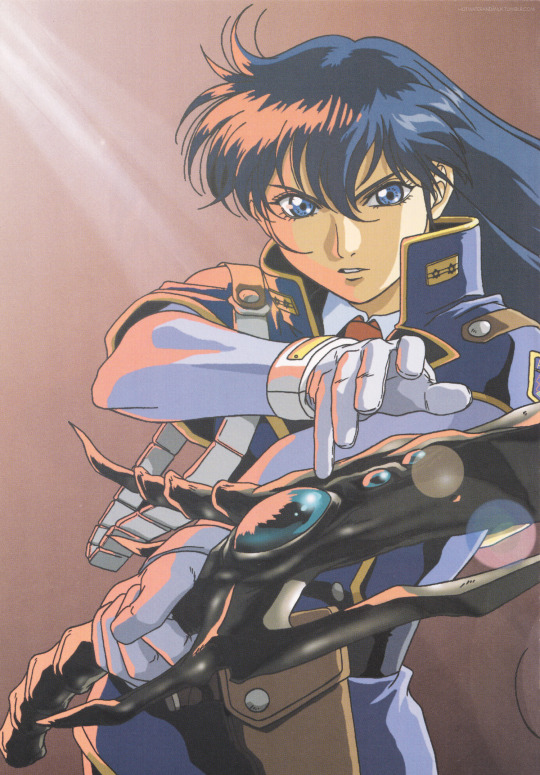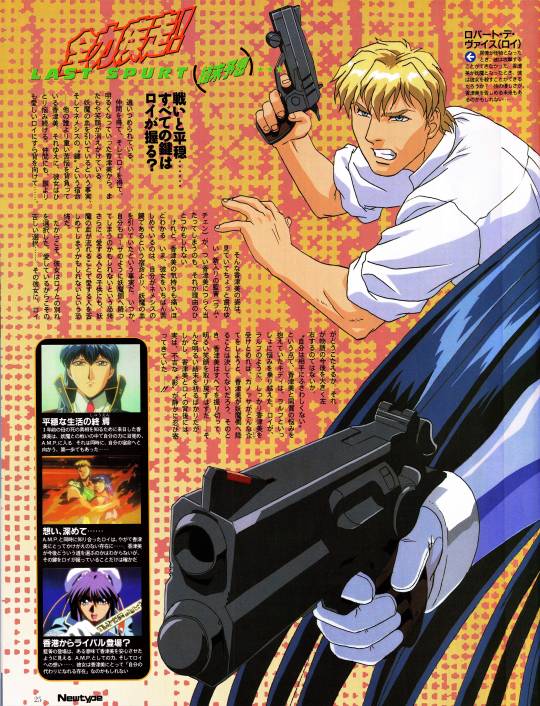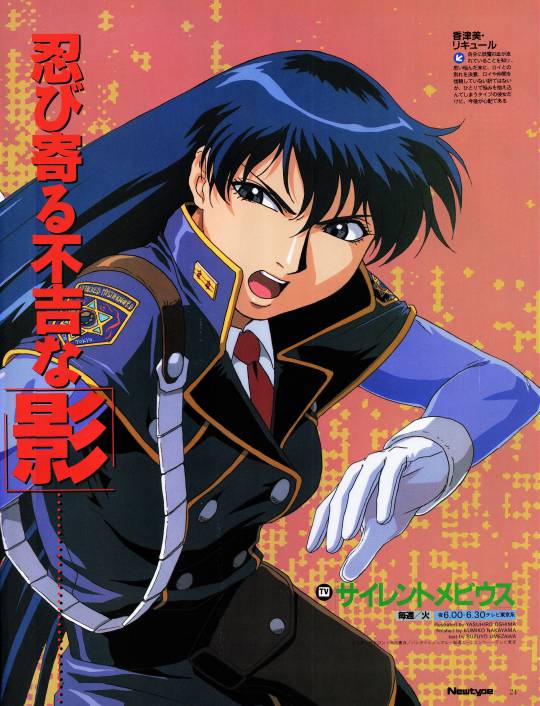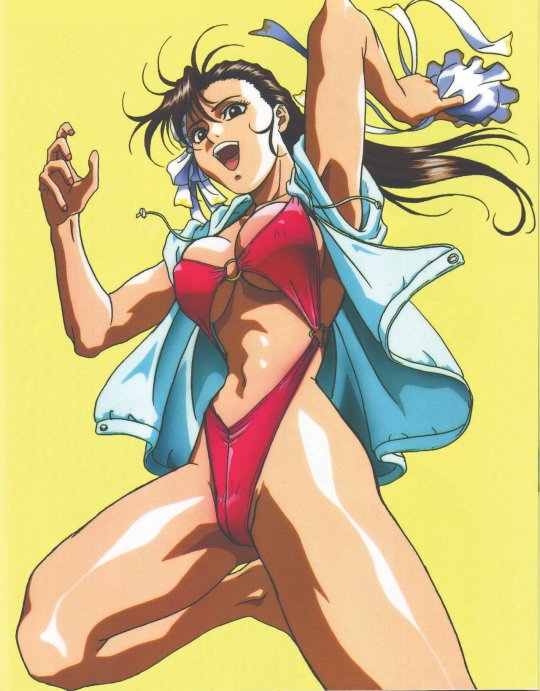#oshima yasuhiro
Text

Yasuhiro Oshima
#street fighter ii the animated movie#street fighter 2#sf2#chun li#cammy white#90s anime#capcom#official art#official artwork
487 notes
·
View notes
Photo

Kazuhiko Kato, Osamu Kitayama, and Norihiko Hashida in Three Resurrected Drunkards (Nagisa Oshima, 1968)
Cast: Kazuhiko Kato, Osamu Kitayama, Norihiko Hashida, Kei Sato, Cha Dei-dang, Fumio Watanabe, Mako Midori. Screenplay: Masao Adachi, Mamoru Sasaki, Tsutomu Tamura, Nagisa Oshima. Cinematography: Yasuhiro Yoshioka. Film editing: Keiichi Uraoka. Music: Hikaru Hayashi.
Nagisa Oshima's attempts to unsettle his audiences usually took the form of serious explorations of social dysfunction like Cruel Story of Youth (1960), Boy (1969), and The Ceremony (1971) or sexually provocative films like In the Realm of the Senses (1976), but Three Resurrected Drunkards plays more like A Hard Day's Night (Richard Lester, 1964) than any of those often grim and brutal excursions into the dark side of contemporary Japanese life. It begins with three young men larking about at the beach, accompanied by a giddy Japanese pop song. When their clothes are stolen and replaced with others, the film goes off into a series of mostly comic mishaps. But there's a dark side to their larking about from the beginning: One of their gags is an attempt to restage the Pulitzer Prize-winning photograph by Eddie Adams of a South Vietnam general pointing a gun at the head of a grimacing Viet Cong prisoner. They take turns playing the general and the victim as the third critiques the grimace on the face of the one playing the victim. It turns out that the clothes thieves are South Koreans who are trying to sneak into Japan to avoid military service in Vietnam. The Koreans have a gun, with which they threaten the three young Japanese. Along the way, they also get involved with a young woman and an abusive older man who may or may not be her husband. At one point, the film simply stops and starts over at the beginning, but this time the characters know what happened in the first part and are able to change things around. It's all a fascinating blend of rock movie high jinks and serious social commentary: Oshima is satirizing the Japanese prejudice against Koreans, among other things. Some of the satire is lost on contemporary audiences, especially in the West, but Three Resurrected Drunkards is a fascinating glimpse into its director's imagination and political indignation.
3 notes
·
View notes
Photo


Series: Silent Möbius
Artist: Oshima Yasuhiro
Publication: ‘Character Book Katsumi Liqueur ~Memoire~’ (04/1999)
Source: Scanned from personal collection
#silent möbius#silent mobius#katsumi liqueur#grosspoliner#oshima yasuhiro#yasuhiro oshima#scan: hotwaterandmilk#art book#artbook scans#art book scans#90s anime#sci-fi anime#retro anime#classic anime#vintage anime#anime scan#cyberpunk#cyberpunk anime#finally got around to pulling apart my duplicate of this book for scanning#the anime never had an art book so this is the best there is for some of these newtype spreads#which is a shame#oshima in particular did some nice art for the series
367 notes
·
View notes
Text


Series: Silent Möbius
Artist: Yasuhiro Oshima
Publication: Newtype Magazine (09/1998)
@hotwaterandmilk
#silent möbius#silent mobius#oshima yasuhiro#yasuhiro oshima#katsumi liqueur#liqueur katsumi#flex#90s anime#retro anime#classic anime#sci-fi anime#anime fashion#newtype magazine#my scans#continuing my birthday scans for shiori#i deleted the blood+ one from yesterday because I became worried it looked bad#I need to just reupload it#but here's a new one in the meantime#happy birthday
86 notes
·
View notes
Photo


#Yasuhiro OSHIMA#大島 康弘#Chun-Li#cammy white#春麗#チュンリー#ChunLi#Chun Li#春丽#キャミィ#cammy#street fighter 2#super street fighter 2#super street fighter 2 turbo#capcom#giantess
42 notes
·
View notes
Photo

Anime V (08/1995) - Compiler illustrated by Yasuhiro Ōshima.
43 notes
·
View notes
Text
INTERVIEW: Fullmetal Alchemist: Brotherhood Composer Akira Senju on Creating Symphonic Alchemy
The Fullmetal Alchemist series is known for its wide-ranging and emotional music, both from the original 2003 Fullmetal Alchemist series to the 2009 revival Fullmetal Alchemist: Brotherhood. Across each series and the movies, composers Michiru Oshima (Fullmetal Alchemist and Fullmetal Alchemist: The Conqueror of Shamballa), Akira Senju (Fullmetal Alchemist: Brotherhood) and Taro Iwashiro (Fullmetal Alchemist: The Sacred Star of Milos) captured the Elric brothers' grand journey into the world of Alchemy, the state government and secret powers that worked behind the scenes. Milan Records, in coordination with Aniplex and Sony Music, is now releasing the all eleven original Fullmetal Alchemist soundtracks for both series for the first time outside of Japan, which you can now listen to right here! To celebrate the release, Crunchyroll had a chance to speak with Fullmetal Alchemist: Brotherhood composer Akira Senju himself!
Senju, born in Tokyo in 1960, studied composition at the Tokyo University of the Arts and would go on to compose some of Japan's most well-known tracks, including the main themes for the 2012 version of Iron Chef, the score for Mobile Suit Victory Gundam and many more live-action and anime series. We spoke with Senju about how he approached creating the music for the 2009 series, the difference between composing music for live-action series and anime, his friendship with JoJo's Bizarre Adventure creator Hirohiko Araki and more!
Akira Senju
How did you first get into composing music?
When I was in junior high school, I knew I wanted to do something in the world of music – classical, jazz, pop, soundtrack – I wanted to be in an environment where I could be passionate about all kinds of music. At that time, I saw a straight path to my future, and I never changed my mind. I went forward without hesitation. I enjoyed the effort to make my dreams come true, my calling, so to speak.
You’ve also worked on a lot of live-action dramas and TV shows. What differences are there in composing music for anime versus live-action (if any)?
In live-action dramas and movies, there is a symbiosis between the dialogue and sound effects. Anime typically has a longer duration and, therefore, capacity, for more music than live-action, so I think of more realistic expressions and original storytelling through music.
Can you describe your experience being asked to compose the music for Fullmetal Alchemist: Brotherhood? Did the project have an impact on your career as a whole?
It is definitely an epoch-making work for me, which I have only done a few times in my career. It was a work in which I was able to express everything I had done up to that point. And this work allowed me to then take the next step in my career.
What was your experience with Fullmetal Alchemist prior to composing music for Brotherhood? Did you read the manga or watch the original 2003 series?
I didn’t listen to any of the previous works to avoid having any sort of preconceived notions, nor did I end up really referencing them in my music. Instead, I carefully read the original work and created music that flowed through the story from scratch. It was a thrilling experience, especially towards the second half, as the original story was written at the same time as the animation, which was a new experience for me.
How did you work with Director Yasuhiro Irie in creating the music for the series?
The three of us, Director Yasuhiro Irie and Sound Director Masafumi Mima, worked together very smoothly and professionally. We had a high level of mutual trust, especially since it was a thrilling project where we were working simultaneously with the original work.
When I think of the sounds of Fullmetal Alchemist, I always remember these big overtures (an opening orchestral introduction to a song) that seem to capture the feeling of the overpowering Amestris government. How else did you try to capture that feeling of the large institutional power of the State Alchemists in the series?
I worked primarily with the large symphony orchestra and choir (Warsaw Philharmonic Choir) in order to express that power.
Is there any particular track that you enjoyed composing the most for Fullmetal Alchemist: Brotherhood?
“Main Theme - The Alchemist” is the track I enjoyed composing the most, as it best depicts the world of this work in a single song.
Now that all three of your Fullmetal Alchemist: Brotherhood original soundtracks will be available to stream, what do you hope fans will notice or pick up while listening to your music?
I think that music is responsible for expression that cannot be put into words. For me, this work is more than ten years old, but it is definitely a masterpiece. I have tried to give the work a sound that will not get old no matter how many years pass, with a spirit both universal and timeless. I hope you will enjoy another world of Fullmetal Alchemist in this music.
Akira Senji Main Theme Cover
(Image via Akira Senju's website)
I also understand that JoJo’s Bizarre Adventure creator Hirohiko Araki drew you for an album cover of your most famous music tracks. Are you a fan of the JoJo’s Bizarre Adventure series?
Hirohiko Araki and I have mutual respect for each other as creators of the same age. We are very close in our personal lives, and as friends, I asked him to draw the cover for our 30th-anniversary album. I love the JoJo’s Bizarre Adventure series.
Any other things you would like to say to fans of your music around the world?
I sometimes feature parts of the Fullmetal Alchemist score in my concerts, but I would love to hold an entire Fullmetal Alchemist concert someday.
Listen to all of the Fullmetal Alchemist
series soundtracks right here!
Kyle Cardine is a Managing Editor for Crunchyroll. You can find his Twitter here.
By: Kyle Cardine
3 notes
·
View notes
Photo



Akiko Yano “Welcome to jupiter”&“Tong Poo”
art direction & design: Keiichiro Oshima
photographer: Hiroshi Manaka
stylist: Yasuhiro Takehisa
2 notes
·
View notes
Photo

Zaion - I Wish You Were Here: Valamikor a jövőben járunk, a múltban egy meteor csapódott a Földbe, amely egy titokzatos vírust hozott magával. Ezt a vírust az emberek elnevezték M34-nek, és egy sajátos tulajdonsága, hogy rendkívüli módon képes mutálódni, minek következtében akit megfertőz, az átalakul egy az emberiség számára ismeretlen biologóiai létformává – röviden mutáns szörny lesz. A megmaradt emberek kifejlesztettek több módszert is a megsemmisítésükre, az egyik ilyen a nano-technológiás biodroidok, ami annyit tesz, hogy akikbe beültetik a nanobotokat, képesek átalakulni és egyfajta páncélt alakítani ki maguk köré, ugyanakkor erejük és gyorsaságuk is sokszorosa lesz a hétköznapi embereknek. Ezt a katonai egységet hívják NOA-nak. Egyik tagja, Tamiya Yuji összeismerkedik egy lánnyal, akiről kiderül, hogy ő az új fegyver, amivel győzhetnek. Azonban a vírus tovább mutálódik és egyre erősebb lesz, vajon meg tudják-e állítani végleg? Műfaját tekintve, ez egy sci-fi akció, egy kis drámával és szerelemmel. A rengeteg harc ellenére az anime értékét mégis a két főszereplő közötti kapcsolat, valamint az érdekes történet adja, ami ha nem is páratlan, mégis kellőképpen kivitelezett és élvezhető. A GONZO 2001-ben adta ki, egy 4 részes OVA keretében,Mizushima Seiji rendezésében. A karakterdizájn gyönyörű lett hála Matsumoto Takaharu eredeti terveinek, amit Oshima Yasuhiro az újdonságaival hasznosított. Még meg sem szólalnak a szereplők de már érezni a hangulatváltozást körülöttük, remek munka. De ezen felül maga az egész grafika gyönyörű, hiába nyolc éves, ma is élvezet nézni. A hangok is jól hallhatóak és élesek, szépen szólnak. A harcoknál az effektek sokat hozzáadnak a fílinghez. Ami ezt még jobban fokozhatja az a zene, erre a szerepre pedíg egy nagyszerű zeneszerzőt sikerült leszerződtetni. Ő pedíg Kawai Kenji, akinek már eddíg is sokat köszönhettünk. A szinkron, mint mindig most is kivételes. Odagiri Joe és Tamura Yukari játékának köszönhetően valóban elhisszük, hogy Yuji és Ai szeretik egymást. Persze, megint csak az egész stáb munkájának köszönhető, hogy sikerült a beleélésükkel megnövelni a hangulatot. #zaioniwishyouwerehere #anime #nagyítóalatt https://www.instagram.com/p/Buh5UaGAN85/?utm_source=ig_tumblr_share&igshid=12v601gcrx3gz
0 notes
Text

Yasuhiro Oshima
#street fighter ii the animated movie#street fighter#sf2#chun li#cammy white#official art#capcom#90s anime#official artwork
469 notes
·
View notes
Photo

Do-yun Yu and Akiko Koyama in Death by Hanging (Nagisa Oshima, 1968)
Cast.: Do-yun Yu, Kei Sato, Fumio Watanabe, Hosei Kamatsu, Rokko Toura, Ishiro Ishida, Masao Adachi, Akiko Koyama. Screenplay: Michinori Fukao, Mamoru Sasaki, Tsutomu Tamura, Nagisa Oshima. Cinematography: Yasuhiro Yoshioka. Music: Hikaru Hayashi.
Nagisa Oshima is one of the great artists of the second half of the 20th century whom nobody has heard of. That's an exaggeration, of course: Lots of cinéastes and students of Japanese film obviously know Oshima's work, but ordinary people who pride themselves on their knowledge of Kurosawa or Ozu often know little about him, unless it's his English-language film starring David Bowie, Merry Christmas, Mr. Lawrence (1983). Maybe it's because Oshima doesn't lend himself to easy description: You can't take any one of his films as representative of the style and content of any of the others. There's a vast difference between the harrowing upperclass family drama The Ceremony (1971) and the poignant account of an abused child's initiation into crime, Boy (1969), or between the scathing look at rootless Japanese young people in Cruel Story of Youth (1960) and what is probably Oshima's best-known film in the West, the sexually explicit In the Realm of the Senses (1976). His willingness to experiment has tagged Oshima as the Japanese Jean-Luc Godard, but he seems to me more the heir to the great modernists of the early-to-mid-20th century: Kafka, Joyce, Faulkner, Brecht, Genet. Certainly Death by Hanging has been singled out as "Brechtian" for its outrageous transformation of politically charged subject matter, capital punishment, into something like tragic farce. It's also "Kafkaesque" in its lampoon of bureaucrats. But mostly it's an audacious transformation of a polemic into an uproarious and finally sad satire. The protagonist (Do-yun Yu) is called "R.," which immediately brings to mind Kafka's "K." He has raped and murdered two young women and is about to hang in the Japanese prison's scrupulously neat death house. But the hanging doesn't take: R. simply doesn't die, and in the ensuing confusion, none of the prison officials knows what to do. There's a flurry of arguments about whether, having survived the hanging, he's even still R., his soul presumably having left the body after the execution. Things grow still more problematic after R. emerges from a post-hanging coma and doesn't remember who he is. Can they hang him again? Much of this hysteria is over-the-top funny, especially the determination of the Education Officer, played with farcical broadness by Fumio Watanabe, to restore R.'s memory by re-creating his past and his crimes. He was the son of poor Korean immigrants, and the satire shifts away from capital punishment to the Japanese treatment of Koreans, as the prison staff voices some of the worst prejudices and stereotypes that the Japanese have of Koreans. Eventually, the Education Officer, trying to re-create one of R.'s crimes, murders a young woman himself. But by that time, the film has departed from any resemblance to actuality into symbolic fantasy. It's a very theatrical film in the sense that even when it departs from the confines of the death house, where most of it takes place, and explores the outside world, talk dominates action. But where that might have been a strike against the film, it adds to its claustrophobic quality, the feeling of being plunged deeply into an absurd but entirely recognizable situation. Maybe that should be called "Oshimaesque."
6 notes
·
View notes
Photo


Series: Variable Geo
Artist: Oshima Yasuhiro
Publication: Anime V Magazine (11/1996)
Source: Scanned from personal collection
#variable geo#takeuchi yuka#reimi jahana#kubota jun#yanase kaori#yajima satomi#oshima yasuhiro#yasuhiro oshima#scan: hotwaterandmilk#anime v#animev#90s anime#fanservice#fanservice anime
73 notes
·
View notes
Text
Concrete DenPaku The Beachfront MIJORA Villas
The Beachfront MIJORA is a collection of villa style tourist accommodations, designed by Yasuhiro “Hiro” Yamashita of Atelier TEKUTO. Situated along a beach in Amami Oshima, a subtropical island in southern Japan, each villa boasts a breathtaking view of the sea. View in gallery View in gallery View in gallery View in gallery View in gallery
More...
The post Concrete DenPaku The Beachfront MIJORA Villas appeared first on HomeDSGN.
Concrete DenPaku The Beachfront MIJORA Villas published first on https://unscratch.blogspot.com/
0 notes
Text
Concrete DenPaku The Beachfront MIJORA Villas
The Beachfront MIJORA is a collection of villa style tourist accommodations, designed by Yasuhiro “Hiro” Yamashita of Atelier TEKUTO. Situated along a beach in Amami Oshima, a subtropical island in southern Japan, each villa boasts a breathtaking view of the sea. View in gallery View in gallery View in gallery View in gallery View in gallery
More...
The post Concrete DenPaku The Beachfront MIJORA Villas appeared first on HomeDSGN.
Concrete DenPaku The Beachfront MIJORA Villas published first on https://bakerskitchenslimited.tumblr.com/
0 notes
Text
Direct effects of Glucose, Insulin, GLP-1, and GIP on bulbospinal neurons in the rostral ventrolateral medulla in neonatal wistar rats
NAOKI OSHIMA, HIROSHI ONIMARU, HIDEHITO MATSUBARA, TAKAHIRO UCHIDA, ATSUSHI WATANABE, TOSHIHIKO IMAKIIRE, YASUHIRO NISHIDA AND HIROO KUMAGAI
In this study the author hypothesised that the bulbospinal neurons in the RVLM are affected by the levels of glucose, insulin, glucagon like peptide-1 [GLP-1] or glucose-dependent insulinotropic peptide [GIP] in diabetes mellitus patients and this may be the underlying cause for the development of hypertension.
For this purpose, whole cell patch clamp technique was used to examine the changes in the membrane potentials of bulbospinal RVLM neurons during superfusion with all these in neonatal wistar rats.
Brainstem-spinal cord preparation was used for the experiments. Low level of glucose infusion stimulated the bulbospinal neurons in the RVLM. While insulin infusion depolarised almost all the neurons and GLP-1 & GIP caused hyperpolarization in the RVLM neurons.
Histological examination was done to identify the specific receptors which was identified as GLUT-3 for glucose. Also for others specific receptors could be identified. All these results suggest that the low level glucose stimulates bulbospinal neurons in RVLM via specific receptors in the neurons
Also increase in insulin and decrease in GLP-1 & GIP may also cause hypertension by stimulating RVLM neurons by their specific receptors.
Mahesh
Year: 2017
Source: https://www.ncbi.nlm.nih.gov/pubmed/28062192
0 notes
